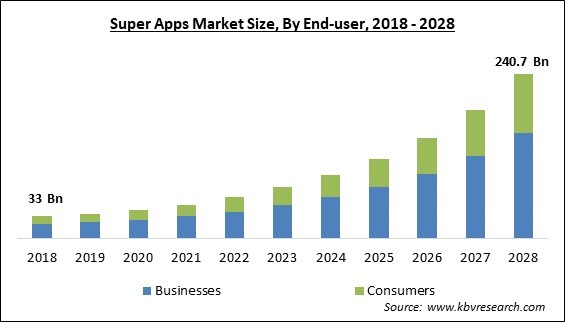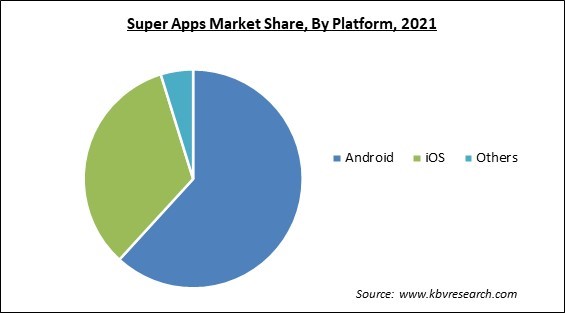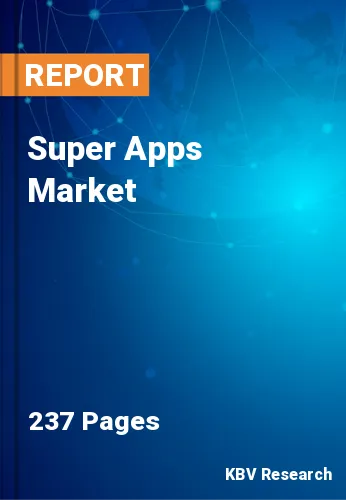The Global Super Apps Market size is expected to reach $240.7 billion by 2028, rising at a market growth of 26.0% CAGR during the forecast period.
A super app is a cellphone application that combines apps that simplify common tasks. It caters to all of a user's needs in a single location. Moreover, Super App lowers the need to download many applications to complete various tasks. Examples of super applications are online shopping, social networking, and banking.

Increasing internet & smartphone usage and increased e-commerce and digital payment use are among the drivers driving the expansion. A super app is a single application that provides multiple functions, such as digital payments, social media, and booking taxis and movie tickets. Moreover, the application provides e-commerce services. As the super app provides most functionalities, users are not obligated to swap between smartphone apps for various use cases. The vast number of services provided by super applications contributes to their high daily usage and user engagement.
The global population is spending more time on mobile devices and downloading apps. The younger generation is more active than, the older population using mobile applications. Additionally, mobile payments are gaining popularity, and cashless payment techniques like mobile wallets or QR code payments are being adopted.
The large unbanked and underbanked population, as well as the presence of prevalent super app players, are contributing to the expansion of the super apps market. As a result, the market for super apps is consolidated, with a considerable share held by market leaders. Established market participants and new entrants provide aggressive price concessions to retain customers and acquire a competitive edge.
Digital payments have gained popularity as a result of the COVID-19 pandemic. As a result, there was an increase in the use of super applications and the services they provided, like digital payments and e-commerce. Technology has grown increasingly essential during the COVID-19 pandemic. Individuals can no longer ignore productivity, technology, and internet access daily. In addition, both employees and students use technology to complete their work and academics. All of this has provided long-term growth potential for mega applications. The pandemic outbreak has so had a positive effect on the super apps market.
Open Banking offers banks an excellent opportunity to take the lead in producing super apps by employing open banking frameworks & APIs to integrate an ecosystem of various industry products & services into a single app. Alternately, banks may develop partnerships with super app platforms that provide payments & banking services via their robust open APIs. Due to the increasing popularity of open banking, the market is anticipated to expand significantly in the future years.
The advent of 4G & 5G network technologies, growing carrier competition, and the uniformity and upgrading of operating systems. Modern cell phones have a huge selection of apps. According to the survey, every smartphone user utilizes more than thirty applications per month to do activities. These apps span a range of categories, from entertainment to social media to commerce to travel. Tech businesses are influenced by the idea of super applications to get rid of this because it enhances user experience and unifies all digital services into a single app. As a result, increasing smartphone usage is predicted to promote market growth.
Super apps require a massive amount of data storage. If these sources are compromised, all the inputs and outputs from users may also be compromised. As a result, users' personal information, including contacts, transaction history, payment card details, and favorite locations, is readily accessible to attackers. Most fintech-based super apps are founded on a simple, lightweight design. As defined by industry standards, they aim to make operations and functions seamless. Thus, separating user experience from trade security is extremely difficult. These security vulnerabilities may limit the use of super apps, consequently impeding market expansion.
Based on platform, the super apps market is segmented into iOS, android and others. The iOS segment covered a considerable revenue share in the super apps market in 2021. Regular software upgrades and security fixes are among the perks iOS devices provide. Thus, iOS devices tend to be more secure than android devices. In addition, iPhone demand is increasing due to rising disposable incomes and iOS's advantages over Android. This strengthens the case for utilizing iOS-based super apps.

By device, the super apps market is bifurcated into smartphone, tablets and others. In 2021, the smartphone segment witnessed the largest revenue share in the super apps market. Due to their smaller size compared to tablets, smartphones are more portable. Also, smartphones are an excellent alternative for communication because they allow users to send & receive messages as well as place and receive calls. Also, because of their size, smartphones may be used one-handedly and fit in a pocket or purse. As a result, customers prefer to use a smartphone for super app services like using a QR code to pay at a grocery store.
On the basis of application, the super apps market is divided into financial services, transportation & logistics services, e-commerce, social media & messaging, and others. The financial services segment garnered a significant revenue share in the super apps market in 2021. Financial services include insurance, electronic wallets or payment, and investment services. When customers sought contactless payment solutions, digital payments intensified in the aftermath of the COVID-19 outbreak. In addition, super applications enable unbanked and underbanked users with digital banking services, allowing them to acquire financial products and conduct online banking.
Based on end user, the super apps market is classified into businesses and consumers. In 2021, the businesses segment registered the maximum revenue share in the super apps market. Using the Business-to-Business (B2B) revenue-generating model, exceptional applications make income from commission fees, advertising fees, and other sources. Advertising produces substantial money for top-tier applications. Companies utilize the super apps platform to advertise their products & services and pay based on the clicks their advertisements receive. In addition, they create income by charging drivers a percentage of their earnings, and restaurants pay commissions.
| Report Attribute | Details |
|---|---|
| Market size value in 2021 | USD 49.1 Billion |
| Market size forecast in 2028 | USD 240.7 Billion |
| Base Year | 2021 |
| Historical Period | 2018 to 2020 |
| Forecast Period | 2022 to 2028 |
| Revenue Growth Rate | CAGR of 26% from 2022 to 2028 |
| Number of Pages | 237 |
| Number of Table | 450 |
| Report coverage | Market Trends, Revenue Estimation and Forecast, Segmentation Analysis, Regional and Country Breakdown, Companies Strategic Developments, Company Profiling |
| Segments covered | Platform, Device, Application, End-user, Region |
| Country scope | US, Canada, Mexico, Germany, UK, France, Russia, Spain, Italy, China, Japan, India, South Korea, Singapore, Malaysia, Brazil, Argentina, UAE, Saudi Arabia, South Africa, Nigeria |
| Growth Drivers |
|
| Restraints |
|
Region wise, the super apps market is analyzed across North America, Europe, APAC, and LAMEA. In 2021, the Asia Pacific region led the super apps market by generating the highest revenue share. Asia-Pacific has a large population and increasing internet and smartphone adoption. Government backing for market participants such as China's WeChat (Tencent) drives the growth of super applications in China. Moreover, after the COVID-19 pandemic, e-commerce sales in Asia-Pacific nations grew substantially. This is anticipated to increase the region's adoption of super apps.
Free Valuable Insights: Global Super Apps Market size to reach USD 240.7 Billion by 2028
The market research report covers the analysis of key stake holders of the market. Key companies profiled in the report include PhonePe Private Limited (Flipkart Private Limited) (Walmart, Inc.), One97 Communications Limited (Paytm Payments Services Limited), Kakao Corp., Tata Group (Tata Sons Private Limited), Ant Group (Alipay) (Alibaba Holding), Grab Holdings, Inc., LINE Corporation (Z Holdings Corporation) (SoftBank Group Corp.), Revolut Ltd., GoTo (Citrix Systems, Inc.) and Rappi, Inc.
By End-user
By Platform
By Device
By Application
By Geography
The global Super Apps Market size is expected to reach $240.7 billion by 2028.
Growing trend of open banking are driving the market in coming years, however, Security issues with super apps restraints the growth of the market.
PhonePe Private Limited (Flipkart Private Limited) (Walmart, Inc.), One97 Communications Limited (Paytm Payments Services Limited), Kakao Corp., Tata Group (Tata Sons Private Limited), Ant Group (Alipay) (Alibaba Holding), Grab Holdings, Inc., LINE Corporation (Z Holdings Corporation) (SoftBank Group Corp.), Revolut Ltd., GoTo (Citrix Systems, Inc.) and Rappi, Inc.
The Android segment acquired maximum revenue share in the Global Super Apps Market by Platform in 2021 thereby, achieving a market value of $145.7 billion by 2028.
The Social Media & Messaging segment is leading the Global Super Apps Market by Application in 2021 thereby, achieving a market value of $74 billion by 2028.
The Asia Pacific market dominated the Global Super Apps Market by Region in 2021, and would continue to be a dominant market till 2028; thereby, achieving a market value of $108.8 billion by 2028.
Our team of dedicated experts can provide you with attractive expansion opportunities for your business.

